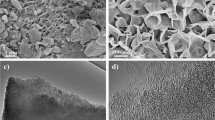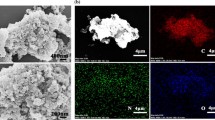Abstract
Nitrogen-doped porous carbons were prepared using a facile method, with low-biotechnology fulvic acid potassium salts as a precursor. The prepared carbons had a high surface area (1623 m2 g−1) and good electrochemical properties, making them suitable electrode materials for supercapacitors. Nitrogen-doped porous carbons were tested as an electrode in both 6 M KOH aqueous solution and different concentrations KNO3 aqueous solution. The nitrogen-doped porous carbons with unique microstructure and nitrogen functionalities exhibited a capacitance of 235 F g−1 in a 6 M KOH aqueous solution. Electrochemical investigation showed that the nitrogen-doped porous carbons exhibited a broad potential operational window in a 2.5 M KNO3 aqueous solution. Furthermore, a high capacitance retention of 88.1 % was achieved even after 5000 cycles at 1.7 V. Potassium nitrate solutions in a wide range of concentrations were also proven to be promising electrolytes for electrochemical capacitors because they are cheap, noncorrosive, electrochemically stable, and compatible to diverse current collectors.








Similar content being viewed by others
References
Winter M, Brodd RJ (2004) What are batteries, fuel cells, and supercapacitors. Chem Rev 104(10):4245–4270
Miller JR, Simon P (2008) Electrochemical capacitors for energy management. Science Magazine 321(5889):651–652
Wang Y, Xia Y (2013) Recent progress in supercapacitors: from materials design to system construction. Adv Mater 25(37):5336–5342
Wang G, Wang H, Lu X, Ling Y, Yu M, Zhai T, Tong Y, Li Y (2014) Solid-state supercapacitor based on activated carbon cloths exhibits excellent rate capability. Adv Mater 26(17):2676–2682
Frackowiak E, Beguin F (2001) Carbon materials for the electrochemical storage of energy in capacitors. Carbon 39(6):937–950
Seredych M, Koscinski M, Sliwinska-Bartkowiak M, Bandosz TJ (2013) Charge storage accessibility factor as a parameter determining the capacitive performance of nanoporous carbon-based supercapacitors. ACS Sustain Chem Eng 1(8):1024–1032
Seredych M, Koscinski M, Sliwinska-Bartkowiak M, Bandosz TJ (2012) Active pore space utilization in nanoporous carbon-based supercapacitors: effects of conductivity and pore accessibility. J Power Sources 220:243–252
Hulicova-Jurcakova D, Seredych M, Jin Y, Lu GQ, Bandosz TJ (2010) Specific anion and cation capacitance in porous carbon blacks. Carbon 48(6):1767–1778
Conway B (1999) Electrochemical supercapacitor. Scientific fundamentals and technological applications. Kluwer Academic/Plenum Publishers, New York
Wang W, Liu W, Zeng Y, Han Y, Yu M, Lu X, Tong Y (2015) A novel exfoliation strategy to significantly boost the energy storage capability of commercial carbon cloth. Adv Mater 27(23):3572–3578
Balogun M-S, Lyu F, Luo Y, Qiu W, Meng H, Li J, Mai W, Mai L, Tong Y (2016) All-flexible lithium ion battery based on thermally-etched porous carbon cloth anode and cathode. Nano Energy
Wu X-L, Wang W, Guo Y-G, Wan L-J (2011) Template-free synthesis and supercapacitance performance of a hierachically porous oxygen-enriched carbon material. J Nanosci Nanotechnol 11(3):1897–1904
Xu B, Yue S, Sui Z, Zhang X, Hou S, Cao G, Yang Y (2011) What is the choice for supercapacitors: graphene or graphene oxide. Energy & Environmental Science 4(8):2826–2830
Lei Z, Bai D, Zhao X (2012) Improving the electrocapacitive properties of mesoporous CMK-5 carbon with carbon nanotubes and nitrogen doping. Microporous Mesoporous Mater 147(1):86–93
Wu Z, Webley PA, Zhao D (2012) Post-enrichment of nitrogen in soft-templated ordered mesoporous carbon materials for highly efficient phenol removal and CO2 capture. J Mater Chem 22(22):11379–11389
D-s Y, T-x Z, S-l Z, W-j Z, S-s M, N-n X (2011) Nitrogen-enriched carbon nanowires from the direct carbonization of polyaniline nanowires and its electrochemical properties. Electrochem Commun 13(3):242–246
Mao Y, Duan H, Xu B, Zhang L, Hu Y, Zhao C, Wang Z, Chen L, Yang Y (2012) Lithium storage in nitrogen-rich mesoporous carbon materials. Energy & Environmental Science 5(7):7950–7955
Hulicova-Jurcakova D, Puziy AM, Poddubnaya OI, Suárez-García F, Tascón JM, Lu GQ (2009) Highly stable performance of supercapacitors from phosphorus-enriched carbons. J Am Chem Soc 131(14):5026–5027
Liu X, Zhou W, Yang L, Li L, Zhang Z, Ke Y, Chen S (2015) Correction: nitrogen and sulfur co-doped porous carbon derived from human hair as highly efficient metal-free electrocatalysts for hydrogen evolution reactions. J Mater Chem A 3(18):10135–10135
Hulicova-Jurcakova D, Kodama M, Shiraishi S, Hatori H, Zhu ZH, Lu GQ (2009) Nitrogen-enriched nonporous carbon electrodes with extraordinary supercapacitance. Adv Funct Mater 19(11):1800–1809
Yang M, Cheng B, Song H, Chen X (2010) Preparation and electrochemical performance of polyaniline-based carbon nanotubes as electrode material for supercapacitor. Electrochim Acta 55(23):7021–7027
Wheeler DA, Wang G, Ling Y, Li Y, Zhang JZ (2012) Nanostructured hematite: synthesis, characterization, charge carrier dynamics, and photoelectrochemical properties. Energy & Environmental Science 5(5):6682–6702
Zhao L, Baccile N, Gross S, Zhang Y, Wei W, Sun Y, Antonietti M, Titirici M-M (2010) Sustainable nitrogen-doped carbonaceous materials from biomass derivatives. Carbon 48(13):3778–3787
Xu B, Hou S, Cao G, Wu F, Yang Y (2012) Sustainable nitrogen-doped porous carbon with high surface areas prepared from gelatin for supercapacitors. J Mater Chem 22(36):19088–19093
Xia Y, Mokaya R (2005) Generalized and facile synthesis approach to N-doped highly graphitic mesoporous carbon materials. Chem Mater 17(6):1553–1560
Stoller MD, Ruoff RS (2010) Best practice methods for determining an electrode material’s performance for ultracapacitors. Energy & Environmental Science 3(9):1294–1301
Xu B, Duan H, Chu M, Cao G, Yang Y (2013) Facile synthesis of nitrogen-doped porous carbon for supercapacitors. J Mater Chem A 1(14):4565–4570
Xu B, Zheng D, Jia M, Cao G, Yang Y (2013) Nitrogen-doped porous carbon simply prepared by pyrolyzing a nitrogen-containing organic salt for supercapacitors. Electrochim Acta 98:176–182
Peter B, Melke J, Muench F, Ensinger W, Roth C (2014) Stable platinum nanostructures on nitrogen-doped carbon obtained by high-temperature synthesis for use in PEMFC. J Appl Electrochem 44(5):573–580
Simon P, Gogotsi Y (2008) Materials for electrochemical capacitors. Nat Mater 7(11):845–854
Galiński M, Lewandowski A, Stępniak I (2006) Ionic liquids as electrolytes. Electrochim Acta 51(26):5567–5580
Dollimore D, Spooner P, Turner A (1976) The BET method of analysis of gas adsorption data and its relevance to the calculation of surface areas. Surface Technology 4(2):121–160
Walton KS, Snurr RQ (2007) Applicability of the BET method for determining surface areas of microporous metal-organic frameworks. J Am Chem Soc 129(27):8552–8556
Chen X, Zhao B, Cai Y, Tadé MO, Shao Z (2013) Amorphous V–O–C composite nanofibers electrospun from solution precursors as binder-and conductive additive-free electrodes for supercapacitors with outstanding performance. Nanoscale 5(24):12589–12597
Wang Y, Su F, Wood CD, Lee JY, Zhao XS (2008) Preparation and characterization of carbon nanospheres as anode materials in lithium-ion secondary batteries. Ind Eng Chem Res 47(7):2294–2300
Sadezky A, Muckenhuber H, Grothe H, Niessner R, Pöschl U (2005) Raman microspectroscopy of soot and related carbonaceous materials: spectral analysis and structural information. Carbon 43(8):1731–1742
Ferrari AC, Robertson J (2000) Interpretation of Raman spectra of disordered and amorphous carbon. Phys Rev B 61(20):14095
Kajdos A, Kvit A, Jones F, Jagiello J, Yushin G (2010) Tailoring the pore alignment for rapid ion transport in microporous carbons. J Am Chem Soc 132(10):3252–3253
Korenblit Y, Rose M, Kockrick E, Borchardt L, Kvit A, Kaskel S, Yushin G (2010) High-rate electrochemical capacitors based on ordered mesoporous silicon carbide-derived carbon. ACS Nano 4(3):1337–1344
Li F, Morris M, Chan K-Y (2011) Electrochemical capacitance and ionic transport in the mesoporous shell of a hierarchical porous core–shell carbon structure. J Mater Chem 21(24):8880–8886
Zhou G, Wang D-W, Li F, Zhang L, Li N, Wu Z-S, Wen L, Lu GQ, Cheng H-M (2010) Graphene-wrapped Fe3O4 anode material with improved reversible capacity and cyclic stability for lithium ion batteries. Chem Mater 22(18):5306–5313
Kulkarni SB, Patil UM, Shackery I, Sohn JS, Lee S, Park B, Jun S (2014) High-performance supercapacitor electrode based on a polyaniline nanofibers/3D graphene framework as an efficient charge transporter. J Mater Chem A 2(14):4989–4998
Datsyuk V, Kalyva M, Papagelis K, Parthenios J, Tasis D, Siokou A, Kallitsis I, Galiotis C (2008) Chemical oxidation of multiwalled carbon nanotubes. Carbon 46(6):833–840
Ye F, Zhao B, Ran R, Shao Z (2014) Facile mechanochemical synthesis of nano SnO2/graphene composite from coarse metallic Sn and graphite oxide: an outstanding anode material for lithium-ion batteries. Chem Eur J 20(14):4055–4063
Jansen R, Van Bekkum H (1995) XPS of nitrogen-containing functional groups on activated carbon. Carbon 33(8):1021–1027
Fan X, Zhang L, Zhang G, Shu Z, Shi J (2013) Chitosan derived nitrogen-doped microporous carbons for high performance CO2 capture. Carbon 61:423–430
Sánchez-Sánchez A, Suárez-García F, Martínez-Alonso A, Tascón JM (2014) Aromatic polyamides as new precursors of nitrogen and oxygen-doped ordered mesoporous carbons. Carbon 70:119–129
Hulicova-Jurcakova D, Seredych M, Lu GQ, Bandosz TJ (2009) Combined effect of nitrogen- and oxygen-containing functional groups of microporous activated carbon on its electrochemical performance in supercapacitors. Adv Funct Mater 19(3):438–447
Jiang H-L, Liu B, Lan Y-Q, Kuratani K, Akita T, Shioyama H, Zong F, Xu Q (2011) From metal-organic framework to nanoporous carbon: toward a very high surface area and hydrogen uptake. J Am Chem Soc 133(31):11854–11857
Zhang J, Zhao X (2012) On the configuration of supercapacitors for maximizing electrochemical performance. ChemSusChem 5(5):818–841
Hulicova D, Kodama M, Hatori H (2006) Electrochemical performance of nitrogen-enriched carbons in aqueous and non-aqueous supercapacitors. Chem Mater 18(9):2318–2326
Zhang LL, Zhao X (2009) Carbon-based materials as supercapacitor electrodes. Chem Soc Rev 38(9):2520–2531
Fic K, Lota G, Meller M, Frackowiak E (2012) Novel insight into neutral medium as electrolyte for high-voltage supercapacitors. Energy & Environmental Science 5(2):5842–5850
Acknowledgments
This work was financially supported by the National Natural Science Foundation of China (NSFC, Nos. 21364004), by the Provincial Natural Science Foundation of Gansu (1506RJZA102), and by the College Students Training Project for Creative and Entrepreneurship of China (201510731005).
Author information
Authors and Affiliations
Corresponding author
Electronic supplementary material
ESM 1
(DOCX 683 kb)
Rights and permissions
About this article
Cite this article
Chen, Y.Z., Li, P., Zhao, X. et al. One-step synthesis of nitrogen-doped porous carbon for supercapacitors utilizing KNO3 as an electrolyte. J Solid State Electrochem 21, 171–181 (2017). https://doi.org/10.1007/s10008-016-3350-0
Received:
Revised:
Accepted:
Published:
Issue Date:
DOI: https://doi.org/10.1007/s10008-016-3350-0




